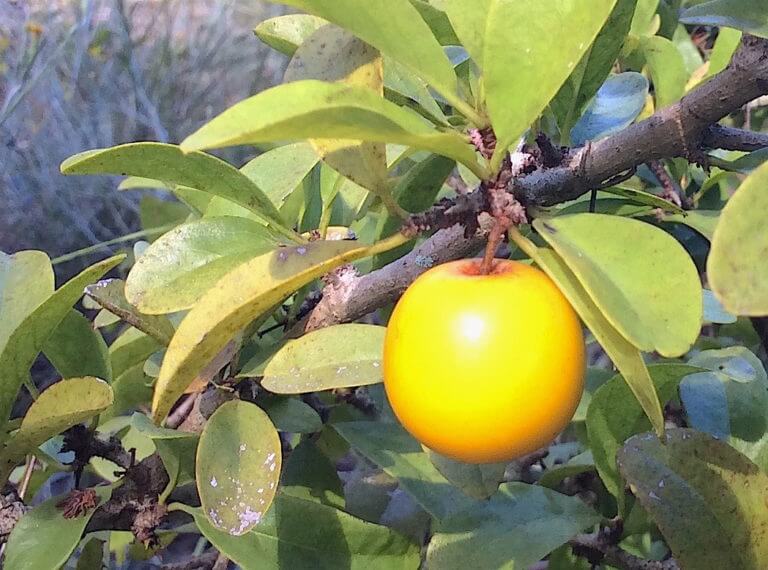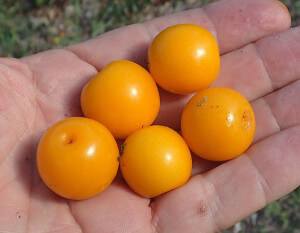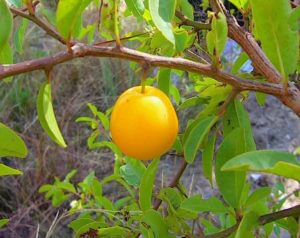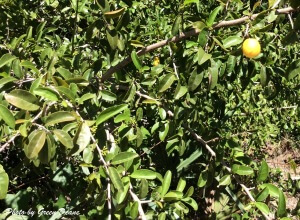Ximenia americana: Known by Many Names
If I listed this edible under its botanical name few would find it. On the other hand it has some three dozen commons names in several languages. So which one does one choose? In English, Tallow Plum is the most accurate.
It has also been called the American plum, blue sour plum, monkey plum, mountain plum, seaside plum, Spanish plum, wild plum, hog plum, and yellow plum though it is not a plum but its leaves can be bluish. Other names include pepenance, coastal prune, spiny prune, Brazilian apricot, spiny apricot, wild apricot, little apricot and little wild apricot though it is not a prune nor an apricot. Then there is ocean cherry, wild cherry and cherry — no, it is not a cherry either; sea lemon, seaside lemon, wild orange, and wild lime…and no it is not a citrus. Others prefer devil’s apple, fiddle apple, little apple and wild quince. Yes, you guessed it again: It is not an apple or any apple relative. Some even call it the Wild Olive. No, it is not related to the olive but it is in the Olax family. Olive/olax… tenuous at best. There is also a darker side with names like purge-nut, cagalera (diarrhea) and fransman moppe (Frenchman’s complaint) a reference to what too many of the seeds can do.
It got the name Tallow Plum because of the waxy texture of the fruit. Botanically it is Ximenia americana (that’s hem-MAY-nee-uh a-mer-ih-KAY-na.) It was named for the Spanish monk Francisco Ximenez, a native of Luna in the Kingdom of Aragon. Americana means of the Americas. It is an important food source in Ethiopia and Brazil.
Found in Florida and south, locally it likes dry scrub areas. The picture above came from the southwest side of the entrance road to Haulover Canal parking lot on the north end of Kennedy Space Center. Tallow Plums here in Florida range from a few feet tall to sprawling shrubs five or six feet tall. In southern hammocks, however, which are islands of hardwoods in wet areas, it can grow to 35 feet.
The yellow fruit, sometimes orange/red particularly when dropped off the tree, is edible raw or cooked. It can range from a bitter-almond in flavor to sweet. The flesh is somewhat astringent and sticky. There is no particular aroma of the fruit but the flowers have an intense lilac aroma. Young leaves, which have a strong aroma of almonds, can also be well-boiled then eaten in small amounts. Think famine food. Do not eat them raw. They contain hydrocyanide.
The oil of the seed is also edible and used for cooking. It has 10 fatty acids, seven unsaturated yielding a total unsaturation of 92.42%. The oil contained essential fatty acids of Linoleic (1.34%), Linolenic (10.31%), Arachidonic (0.60%) and varying levels of unsaturated higher fatty acids, specifically Eicosatrienoic (3.39%), Erucic (3.46%) and Nervonic (1.23%) acids. The level of Oleic acid is 72.09%. the fruit has chigh levels of vitamin C (160,26 mg per100 g), yellow flavonoids (43,12 mg per100 g), total extractable polyphenols (3066,48 mg per 100 g) and antioxidant activity (365,55 g fruit/g DPPH e 251,70 μmol Trolox/g.
The pulp of the seed itself is purgative raw, and is used as a seasoning. A few can be eaten after cooking but if too many cooked ones are consumed, like the raw ones, they becomes a most efficient laxative. The fruit is known to quench thirst, is used as a drink and in making jams and jellies. In Tazania the Sandawe (Bushmen) rely on the fruit as a staple. The seed oil is use for skin moisturizing and as of this writing is commercially available costing $5 and ounce, not counting shipping.
Addendum March 2018: A strapping, young, adult male reported to me that he ate about 20 Gopher Apples and 10 Tallow Plums at one sitting. They gave him temporary premature ventricular contractions which he verified by a heart monitor. And they went away in a short while. Thus we don’t which fruit might have caused said, or a combination of them, the amount, or if it was a personal sensitivity or something else entirely.
Green Deane’s “Itemized” Plant Profile
IDENTIFICATION: A shrub to a small tree, branches long, zig-zaggy, vine-like, semi-climbing, thorny; leaves alternate, yellowish-green in the scrub, darker green in hammocks, oblong or elliptic, rounded or notched at the apex, or spine tipped, one to three inches long, some times in clusters of three. Flowers yellowish, four petals, 3/8 inch wide, hairy within, very fragrant, similar to lilac, in small clusters. Fruit a broad oval or nearly round, to 1.5 inches long, skin smooth, bright yellow to orange red, flesh yellow, bitter almond to sweet flavor, sub acid to acid. Seed large, oval, buff-colored with white nut like kernel. The wood is very dense and the plant can be parasitic.
TIME OF YEAR: Spring and fall
ENVIRONMENT: Dry scrub lands to hardwood hammocks. For several decades I only found them in coastal areas. But this past year I found one under a pine west of Orlando, mid-state.
METHOD OF PREPARATION: Fruit edible raw or cooked, used for juice, jelly, jam and wine. Kernel roasted but in limited quantities, seed oil is edible and can also be used in making soap, lubrication and a vegetable butter. Young leaves can be boiled and eaten sparingly. Raw fruit picked when unripe. The fruit is high in Vitamin C and oil that has been used externally on hair and as a skin softener.
HERB BLURB
The bark, fruit, and leaves have several medicinal uses. Leaves and twigs are used to treat fever, colds, as a laxative and an eye lotion. Leaves are used for headaches, angina, and a poison antidote. Roots are used for skin problems, headaches, venereal disease, sleeping sickness, and water retention. The fruit has been used for constipation. The bark has been used for febrile headaches, bath water for sick children, for kidney and heart complaints, and applied to skin ulcers. Stem bark methanolic and water extracts of showed a spectrum of activity against E coli, P. vulgaris, S. aureus, P. aeruginosa and B. subtilis.






I pulled up a plant yesterday and I am going to try to pot it.
Can the seeds be planted and will they grow in your back yard?
Oh yeah, the seeds like to grow.
I was wondering where I could buy this fruit. I am doing a letters of the food-alphabet art project so I’d like at least one fruit. I am in Tennessee, and know of one fairly large international food market fairly close by. Would this be a good place to start looking? Is there an online market I could order from? Thanks for any help.
It’s a seasonal wild fruit, not sold on any market that I know of.
Found several tallow plum trees in a preserve area in SE Collier County FL just east of Collier Blvd. Trees are about 10 feet tall and grow among palm and Pine trees in coral laden soil. They bore fruit from June until the end of August.
Can you give the name of the preserve please? I can’t think of any preserves east of Collier Blvd, only on the west side!
I want to try to grow this plant!
Is this a tree? A bush? Haven’t seen one in person, but they look good.
It’s a shrub, and can be parasitic.
Parasitic or epiphytic?
Hemiparasitic, like sandalwoods, Indian paintbrush (Castlleja sp .) and “wild foxgloves” (Agalinus sp.). It grows in the ground, not epiphytically. It does photosynthesize, so it isn’t a holoparasite (like Indian pipes or Raffelesia), but is capable of attaching to the roots of some neighboring plants to steal minerals, water, and perhaps other stuff.
We have a small grove of the Tallow Plums at the St. Augustine Lighthouse & Maritime Museum. It took us some time to identify them. I grew up in NE Florida and have never seen these plants before. Our guests see them and are curious. Glad we can tell them what they are now.
I found these srubs growing wild in a wooded area in my community in Orlando, Fl. The fruit is still blooming in mid September. It looked edible and am happy to find out it is. I’m going to toss the seeds in the wooded area behind my home and hope to have my very own tallow plums.
I have seen this plant growing right at the water’s edge of the Peace river in Desoto County. There were about 10 trees spread out over about one half a mile of the river bank where it is obviously an area prone to flooding. some of the trees were over 20 feet tall. They were delicious.
Another different species also called HOG PLUM which I have in my yard.
The true yellow mombin, S. mombin L. (syn. S. lutea L.) is most often called hog plum in the Caribbean Islands. In Jamaica, it is also known as Spanish plum, or gully plum. See, https://www.hort.purdue.edu/newcrop/morton/yellow_mombin_ars.html
I cannot find when to harvest. Does anyone know when I can pluck from tree and how long to wait to eat?
We have at least three of these in our back yard in North Fort Myers. We didn’t plant them, they came up on their own.
I’ve seen these growing in Big Cypress and Fakahatchee Preserves. Nearly every time I pick one, I get poked by the spine. I haven’t gotten the courage to eat one yet. They smell fruity sweet to me when I break them open.
I found this tree and when i saw it i thought it was a different kind of plum, but when i smell it, it did not had the plum smell. It smell more like passion fruit, by the way it is on the Island of Roatan in Honduras
I live in southwest Trinidad in the Caribbean and I saw this fruit whilst hiking the shoreline. I was tempted to eat it at first but I picked TWO of it and went home and researched it , I then
realized it was edible so I am going back to harvest some in a bit
At the time this comment was made, the tallow wood is flourishing in west central Florida. Beautiful tasty fruit.
But do be wary when foraging that many organisms in the ecosystem rely on this crop for sustenance.
I live in Yorkshire, UK and have one of these in my garden. I’ve never planted it so must be a self seeder. It has dropped fruit before but not like this year… fruit in abundance with piles dropped every day for the last 3 weeks.
I have one growing in my neighborhood in Jacksonville Florida near the St. John’s River. Not sure if it was planted by a homesteader or is wild. I live in an old neighborhood that was once large forested lots (Live Oak and Hickory) there is also a Loquat planted close by so I have a feeling they were planted by humans.
I eat these on hikes. They’re best when barely touching them makes them drop off the bush. If u have to to pull to pick them they’re still fairly astringent (IMO)
Hi… I live on the north shore of Lake Erie in Ontario Canada. There is a Tallow plum growing in my side yard that is almost 3 feet high. This is the first year I have noticed fruit on it. It was here when I bought the house 6 years ago, but has tripled in size. The fruit is sweet and plum like. Right now the squirrels are busy harvesting the tree.
Oops… that should say 30 feet high, not 3 feet.
Quite positive I just found one of these, my first foraging gather, in a scrub pine on the east coast of South Florida.
They stuck out like a sore thumb in the sandy, green/brown landscape. The one I tasted was very sweet, I want to let the others ripen a bit.
I have been chopping these from my back yard as I hand clear my 1.5 acre scrub in south central FL. Really nasty thorns and tried some fruit which was bitter but somewhat sweet. Now on the few last trees to clear I find this website, thinking I will save them and try to prune into a canopy. I’d estimate them at least 20 feet tall, curious on how to process them for the oils and soaps.